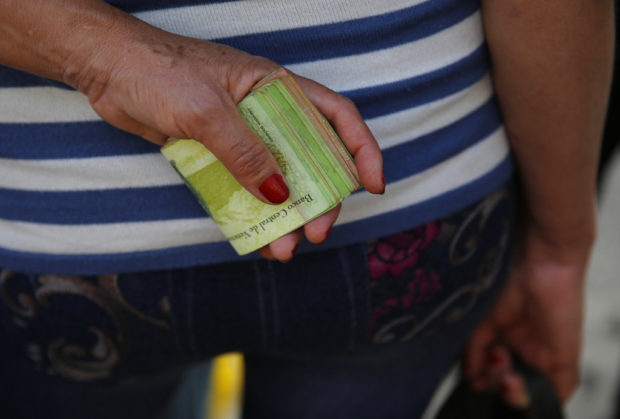
In this Feb. 7, 2018 file photo, a woman holds a wad of bills to pay her bus fare in Caracas, Venezuela. The IMF predicted on Monday, Oct. 8, 2018, that inflation in Venezuela would reach 1.4 million percent this year. AP FILE
WASHINGTON, United States – What does it look like to have inflation of 10 million percent? When something that cost $1 now costs $100,000, is there even a way to calculate the impact?
After seeing prices surge an already-unthinkable 1,000 percent last year, hyperinflation in Venezuela’s imploding economy is set to hit nearly 1.4 million percent this year, the International Monetary Fund forecast in its World Economic Outlook released Monday.
But in 2019 that hyperinflation is expected to leave earth’s orbit, hitting 10 million percent, a figure so large and improbable, readers of the report had to count the zeroes to make sure they had the correct number.
It is so bad that Venezuela was left out of the inflation calculations for the region and for all emerging markets since it would throw off the average.
After years of economic mismanagement, and with the vital oil industry nearly at a standstill, Venezuela has seen tens of thousands of people flee the country daily, increasingly desperate to find food and medicines, flooding into neighboring Colombia and Brazil.
The Venezuelan economy contracted 14 percent last year and is expected to fall another 18 percent this year, but the good news — if it can be called good — is that with little room left to fall it is only forecast to shrink five percent in 2019, the report said.
GDP per capita is estimated to have declined by more than 35 percent over 2013–17 and is projected to decline by close to 60 percent between 2013 and 2023, the IMF said.
With notable understatement, the IMF said “hyperinflation is expected to worsen rapidly, fueled by monetary financing of large fiscal deficits and loss of confidence in the currency.”
Venezuela devalued its currency by nearly 100 percent on August 20.
Excluding Venezuela, inflation in emerging and developing nations is expected to reach only five percent this year, the IMF said.
Downgraded growth
While the news is not nearly so bleak elsewhere, the IMF cut its forecast for world growth to 3.7 percent for this year and next, largely due to the expected slowdown in trade amid the trade war between the United States and China.
It also downgraded its estimate of growth in emerging and developing countries compared to the July forecasts, to 4.7 percent for 2018 and 2019.
And for Latin America and the Caribbean, the forecast was cut four tenths to 1.2 percent for this year, and 2.2 percent next year, according to the WEO.
The IMF now expects Argentina’s economy to contract by 2.6 percent this year, and 1.6 percent next year, with inflation of nearly 32 percent both years.
Argentina, which has seen its economy roiled and currency weaken sharply, agreed late last month with the IMF on a revised reform program that will increase a loan approved in July by $7 billion to $57 billion over three years. The IMF board has yet to approve the updated loan.
Despite a 2,000 basis point increase in Argentina’s interest rate the currency declined by 40 percent through September
Meanwhile, Brazil’s economy is expected to grow only 1.4 percent this year, four-tenths slower than the July forecast, and 2.4 percent in 2019.
The report cited the impact of a nationwide truck drivers’ strike, as well as tightening financial conditions.
Growth in Mexico was downgraded also, but only slightly, to 2.2 percent this year and 2.5 percent next year, buoyed by solid US growth, the IMF said. /cbb